Brightness and Contrast Ratio
For those that need accurate colors, hardware color calibration is basically a given. Here, we report scores for the same areas as we did on the previous page, only this time the results are taken after we have used Monaco Optix XR Pro to calibrate the display.
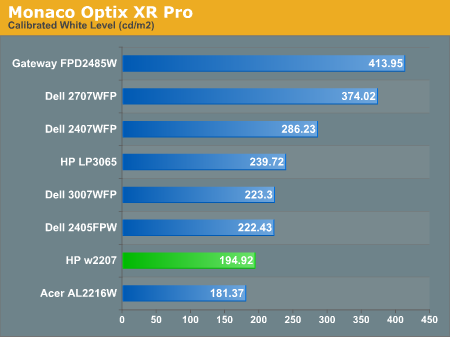
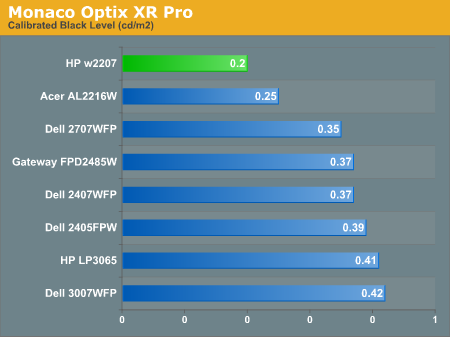
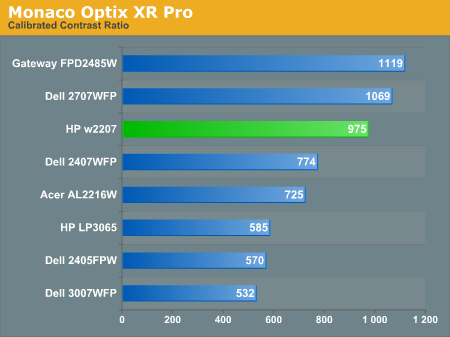
Calibration almost always results in the use of decreased brightness levels, and all of the displays end up running at less than their maximum brightness. You can of course choose to run a display at a higher than recommended brightness level, and the ambient lighting in a room will also determine what brightness setting is best. Our testing was performed indoors with a moderate amount of lighting, and the displays were adjusted according to directions. We also found that manually reducing the brightness level to something more reasonable (like 200-300 nits) did not significantly affect the results on any of these displays, so consider the above charts as more of a maximum recommended brightness for each particular LCD. The HP w2207 continues to generate very good contrast ratios, thanks to the very dark blacks it produces.
Color Accuracy
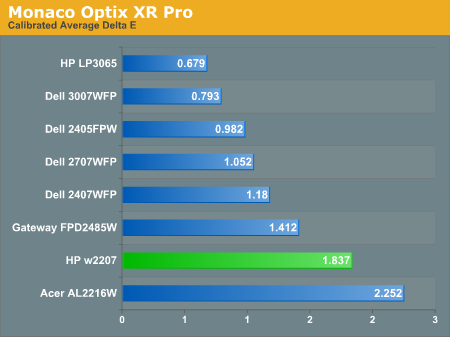
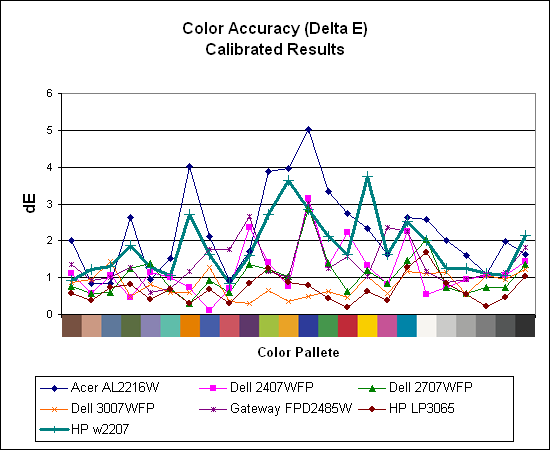
Calibration improves the color accuracy results significantly on all of the displays, although the HP w2207 remains in second to last place. Where the Acer was the best uncalibrated display, it becomes the worst scoring display after calibration. However, outside of professional image editing virtually any of the displays provide acceptable colors once calibrated.
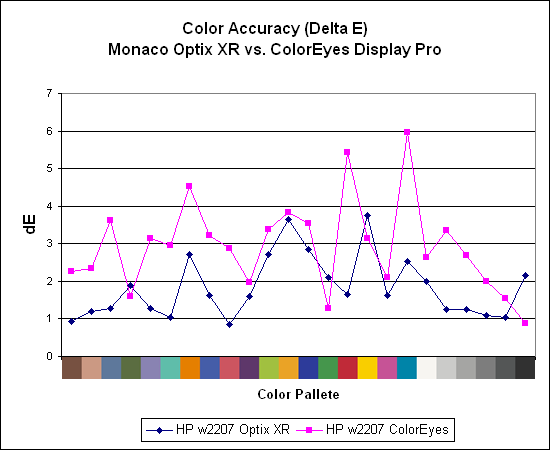
After discovering during our laptop display tests that certain displays appear to respond better to different calibration software, we decided to use ColorEyes Display Pro to test desktop LCDs as well. So far, we have yet to encounter a desktop LCD that scores better using ColorEyes Display Pro, which is actually surprising to us. Monaco Optix XR is an older software package that hasn't been updated since 2004, but it continues to work very well. Both packages also run under Windows Vista, though installation of the colorimeter drivers requires quite a bit more jumping through hoops and even after calibration we're still not entirely sure that Vista is using the color profiles properly. The testing and evaluation process works with the correct color profiles, but outside of the applications Vista seems to change color profiles at times.
For those that need accurate colors, hardware color calibration is basically a given. Here, we report scores for the same areas as we did on the previous page, only this time the results are taken after we have used Monaco Optix XR Pro to calibrate the display.



Calibration almost always results in the use of decreased brightness levels, and all of the displays end up running at less than their maximum brightness. You can of course choose to run a display at a higher than recommended brightness level, and the ambient lighting in a room will also determine what brightness setting is best. Our testing was performed indoors with a moderate amount of lighting, and the displays were adjusted according to directions. We also found that manually reducing the brightness level to something more reasonable (like 200-300 nits) did not significantly affect the results on any of these displays, so consider the above charts as more of a maximum recommended brightness for each particular LCD. The HP w2207 continues to generate very good contrast ratios, thanks to the very dark blacks it produces.
Color Accuracy


Calibration improves the color accuracy results significantly on all of the displays, although the HP w2207 remains in second to last place. Where the Acer was the best uncalibrated display, it becomes the worst scoring display after calibration. However, outside of professional image editing virtually any of the displays provide acceptable colors once calibrated.

After discovering during our laptop display tests that certain displays appear to respond better to different calibration software, we decided to use ColorEyes Display Pro to test desktop LCDs as well. So far, we have yet to encounter a desktop LCD that scores better using ColorEyes Display Pro, which is actually surprising to us. Monaco Optix XR is an older software package that hasn't been updated since 2004, but it continues to work very well. Both packages also run under Windows Vista, though installation of the colorimeter drivers requires quite a bit more jumping through hoops and even after calibration we're still not entirely sure that Vista is using the color profiles properly. The testing and evaluation process works with the correct color profiles, but outside of the applications Vista seems to change color profiles at times.










43 Comments
View All Comments
Bjoern77 - Thursday, August 2, 2007 - link
You'll find that Monitor to be very popular in Europe, specially Germany due to it's low price.Well - low price compared to other monitors.
EG, the Dell 2407 WFP HC is supposed to cost around 1000$ here, the older version is on "sale" for about 850$. If i see the US-Prices for tfts...ouch. Same goes for a lot of other monitors. The HP is the first i noticed on the us markt which seem to be on a European price level, which, i assume, is at least 25% higher.
trajan - Wednesday, August 1, 2007 - link
The one thing I immediately noticed from the review was the difference between the Gateway 24" and the Dell 24". I've never seen these ratings before -- it looks like in most catagories the Gateway is superior. Am I reading this right? I thought the Dell was the hands down 24" champion!JarredWalton - Wednesday, August 1, 2007 - link
The Gateway has a brighter backlight, but in most other areas I felt the 2407WFP and the FPD2485W were about the same. I prefer the appearance of the Dell LCD over the Gateway LCD, and the extremely bright backlight on the Gateway means that you usually have to spend more time tuning things if you don't want to be blinded. If you had them both set to the same intensity, however, I don't think most people would be able to tell the difference between the panels.nilepez - Wednesday, August 1, 2007 - link
I'm still using an old CRT, and I don't know why one would compare at a monitor with a max resolution of 1600x1050 to a CRT that was likely capable at least 1800x1440 and 1920x1440 was fairly common. Mine goes higher, but the refresh rate is too slow at that point.I personally think that the 24" displays are the first ones that are comparable to 21" monitors. The 22" monitors are more comparable to some of the better 19" monitors (though I suppose there may have been crappy 21" monitors with a max usable res of 16x12.
I personally wish I could justify the 30" monitors, but at current prices, I'd be better off going dual monitor with 2 24" models (desktop space is king :) )
Jodiuh - Wednesday, August 1, 2007 - link
Have you seen a nice 20in S-IPS next to your old CRT? I have an older 19in CRT and it pales in comparison to the NEC or Dell panels.yyrkoon - Thursday, August 2, 2007 - link
I had a professional grade 21" CRT next to my 19" WS LCD, and I have to say that the LCD is much, MUCH better for vibrance/image sharpness. The LCD to boot was also 1/5th-1/6th the cost of the 21" CRT . . .nilepez - Wednesday, August 1, 2007 - link
Probably not, given that most stores carry crappy monitors, but I'm really not willing give up real estate to move to a flat screen.even at 1920x1440, I feel cramped if I'm I've got more than 2 instances of jedit open (and I'd really like to have 4, and occasionally more, in most cases).
24" monitors are the smallest monitors with sufficient resolution, although even then, my desktop shrink by almost 20%.
Great Googly Moogly - Thursday, August 2, 2007 - link
Well, it seems you're forgetting about pixel pitch. Those 1920x1200 24" have quite a high pixel pitch. Certainly a 20.1" LCD with a 1600x1200 resolution is better for you?The only LCDs with a decent pixel pitch not stuck in 1991 (seriously) are the 1280x1024 17" (too small, physically, though), 1600x1200 20.1" and the 2560x1600 30".
The new 1920x1200 26-27" are really atrocious, and the most popular 1680x1050 22" is not up to my standards either--hence the main reason (out of many) why I'm still on an iiyama CRT. And if this trend is still going in a few years, we'll have 720p 40" computer monitors. And everyone will love them.
So sick and tired of computer display tech going steady backwards since the 90s.
jc44 - Thursday, August 2, 2007 - link
To be fair 2001 was a good year for displays - IBM built the first T221s (24" 3840x2400) :-) 2006 was not such a good year - IBM ceased production of T221s with nothing even vaguely equivalent in sight from anybody :-(strikeback03 - Thursday, August 2, 2007 - link
Didn't they cost somewhere around $30,000? no wonder they disappeared.